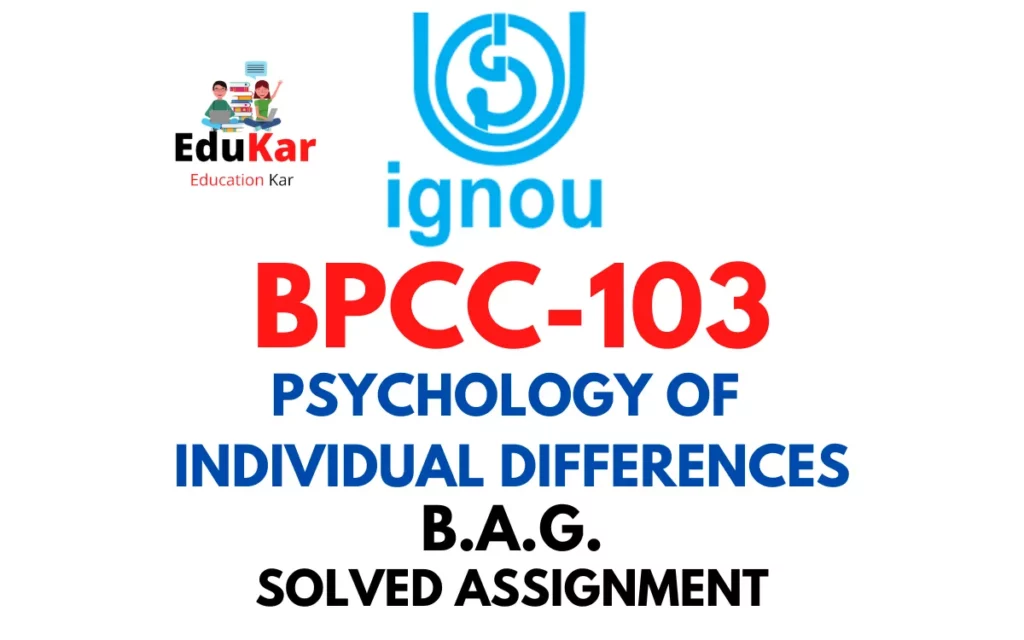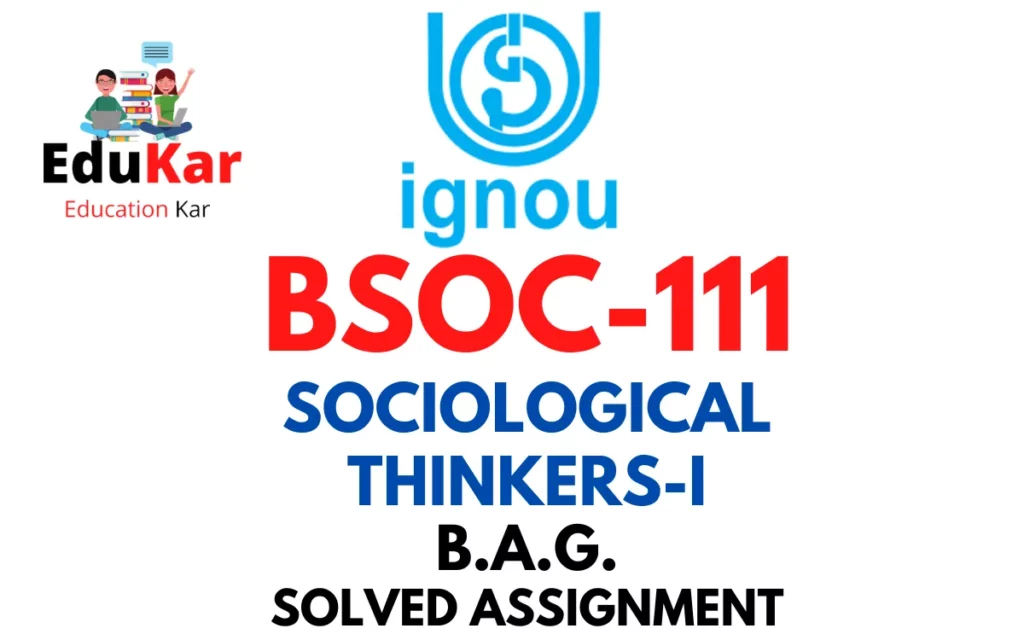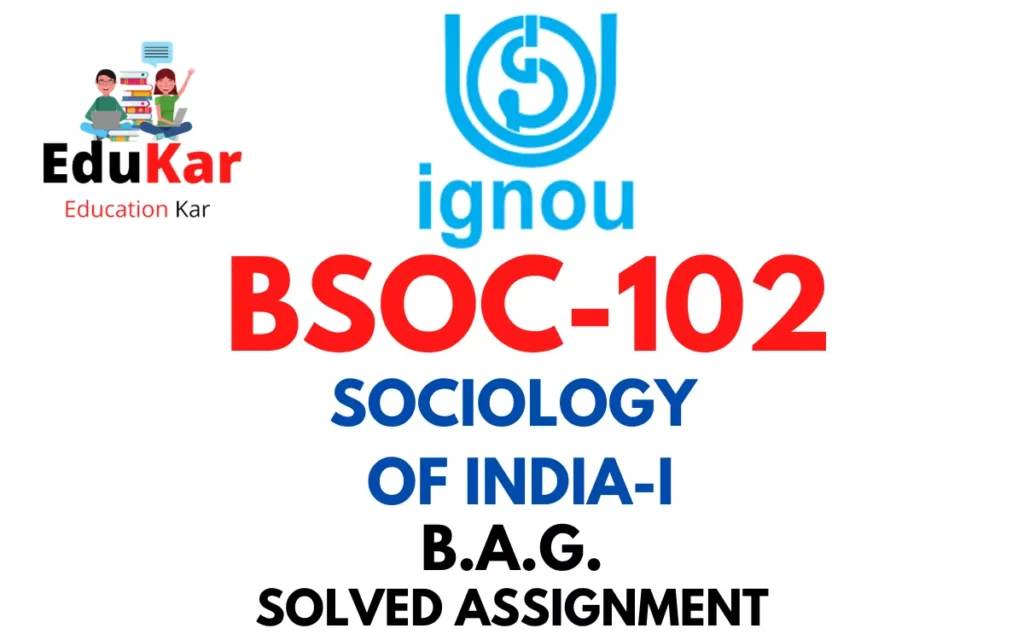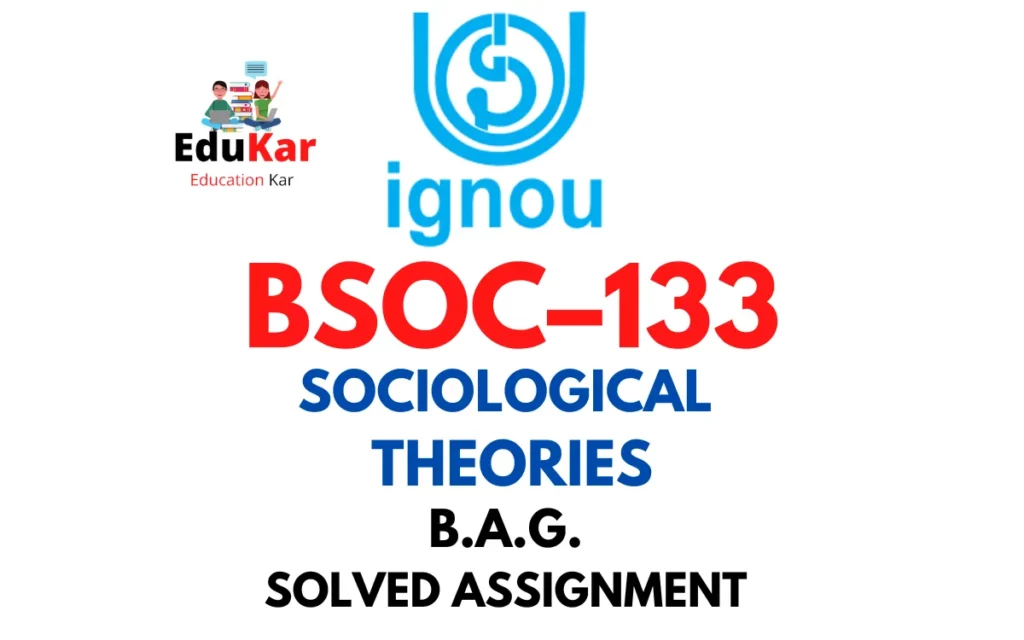Contents
- 1 Assignment I
- 2 Answer the following Descriptive Category Questions in about 500 words each. Each question carries 20 marks.
- 3 1. Discuss intellectualist theories of religion.
- 4 2. Evaluate Max Weber’s studies on religion and economy.
- 5 Assignment II
- 6 Answer the following Middle Category Questions in about 250 words each. Each question carries 10 marks.
- 7 3. Discuss the factors influencing the relationship between religion and politics.
- 8 4. Discuss Malinowski’s perspective on ritual.
- 9 5. Explain the types of pilgrimage described by Turner.
- 10 Assignment III
- 11 Answer the following Short Category Questions in about 100 words each. Each question carries 6 marks.
- 12 6. Explain Weber’s view on priest.
- 13 7. What is Sufism?
- 14 8. What is the difference between belief and ritual?
- 15 9. What is the social significance of religious festivals?
- 16 10. What are the three phases of rites of passage outlined by Van Gennep?

| Title | BSOC-106: IGNOU BAG Solved Assignment 2022-2023 |
| University | IGNOU |
| Degree | Bachelor Degree Programme |
| Course Code | BSOC-106 |
| Course Name | SOCIOLOGY OF RELIGION |
| Programme Name | Bachelor of Arts (General) |
| Programme Code | BAG |
| Total Marks | 100 |
| Year | 2022-2023 |
| Language | English |
| Assignment Code | BASOH/BSOC 106/ 2022-23 |
| Assignment PDF | Click Here |
| Last Date for Submission of Assignment: | For June Examination: 31st April For December Examination: 30th September |
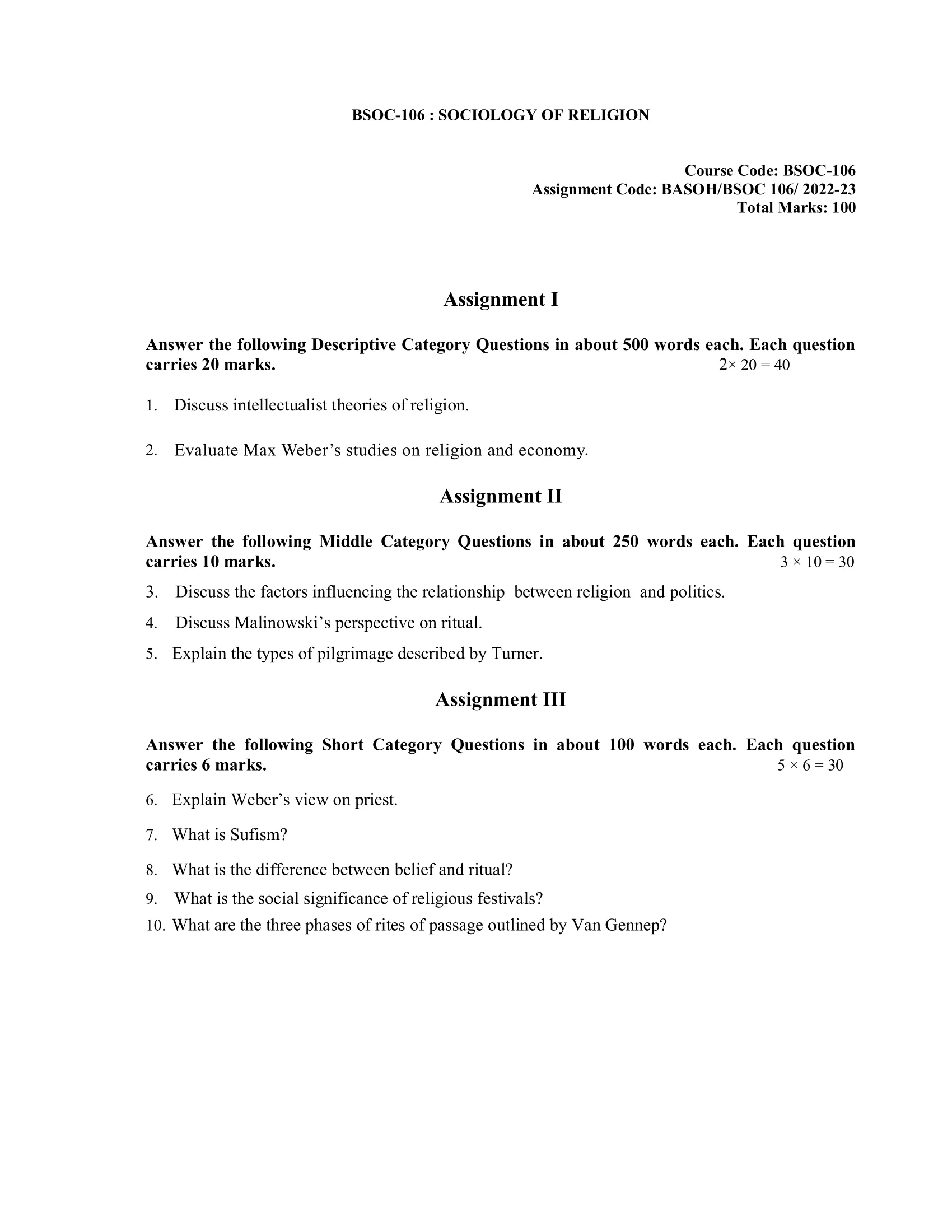
Assignment I
Answer the following Descriptive Category Questions in about 500 words each. Each question carries 20 marks.
1. Discuss intellectualist theories of religion.
Ans: Intellectualist theories of religion are a class of theories that emphasize the cognitive or intellectual aspects of religious belief and practice. These theories propose that religious ideas and practices are primarily the result of human rationality and reflect a quest for truth, knowledge, and understanding.
One of the main intellectualist theories of religion is the cognitive theory of religion. This theory argues that religious beliefs and practices are the result of cognitive processes, such as perception, attention, memory, and reasoning. According to this theory, religion is a byproduct of our evolved cognitive architecture, which allows us to make sense of the world around us and to detect patterns and agency in our environment. As a result, religious beliefs and practices reflect our innate cognitive biases, such as our tendency to attribute intentionality and purpose to natural phenomena, our preference for social cohesion and conformity, and our reliance on authority and tradition.
Another intellectualist theory of religion is the rational choice theory of religion. This theory proposes that religious beliefs and practices are the result of individual rational choice, based on the perceived costs and benefits of participation in religious communities. According to this theory, individuals choose to belong to a particular religious group based on their evaluation of the advantages and disadvantages of membership, such as the opportunities for social networking, the sense of belonging, the moral guidance, and the promise of salvation. Moreover, this theory assumes that religious groups compete with each other for members, and that individuals select the group that best satisfies their needs and preferences.
A third intellectualist theory of religion is the intellectualist theory of myth. This theory argues that myths are not merely fanciful or irrational stories, but rather represent a cognitive tool for understanding the world and for creating meaning and purpose. According to this theory, myths express fundamental human concerns, such as the origins of the world, the nature of humanity, the meaning of life, and the relationship between humans and the divine. Moreover, myths are seen as a symbolic language that allows individuals to express their deepest fears, hopes, and aspirations, and to create a shared worldview that unifies and inspires the community.
2. Evaluate Max Weber’s studies on religion and economy.
Ans: Max Weber, the German sociologist, is widely regarded as one of the founders of modern sociology. Among his many contributions to the field, his studies on the relationship between religion and economy have been particularly influential. In this essay, I will evaluate Weber’s studies on religion and economy, focusing on their strengths and weaknesses.
Weber’s most famous work on the topic is his book “The Protestant Ethic and the Spirit of Capitalism,” published in 1905. In this book, Weber argues that the rise of modern capitalism in Europe was closely linked to the Protestant Reformation, particularly the Calvinist branch of Protestantism. According to Weber, Calvinism provided a set of religious values that encouraged hard work, frugality, and rational calculation of profit and loss. These values, in turn, led to the accumulation of capital, the development of the modern market economy, and the rise of the bourgeois class.
One of the strengths of Weber’s study is his use of historical evidence to support his argument. He extensively researched the writings of Calvinist theologians and the economic behavior of early capitalists to make his case. He also compared the economic performance of Protestant and Catholic countries during the early stages of capitalism and found a correlation between Protestantism and economic growth. This empirical approach gave Weber’s argument credibility and has influenced subsequent studies on the topic.
Another strength of Weber’s study is his emphasis on the cultural and ideological factors that shape economic behavior. Unlike earlier economists who saw economic activity as purely rational and self-interested, Weber recognized that beliefs, values, and norms played a crucial role in shaping economic activity. He argued that religious ideas, in particular, could have a profound impact on economic behavior and the development of economic systems.
However, Weber’s study has also been subject to criticism. One of the main criticisms is that his argument is overly deterministic and reductionist. Weber’s theory suggests that the religious beliefs of early Protestants directly caused the rise of modern capitalism. However, this view overlooks the complex historical and institutional factors that contributed to the development of capitalism, such as technological innovation, colonial expansion, and state policies.
Another criticism is that Weber’s study is Eurocentric and ignores the role of other cultures and religions in economic development. Weber’s theory focused exclusively on Europe and did not consider the economic experiences of other parts of the world. Moreover, Weber’s study assumes that religion is a monolithic and homogeneous force, whereas in reality, religions are diverse and dynamic, and their impact on economic behavior can vary greatly across time and space.
Assignment II
Answer the following Middle Category Questions in about 250 words each. Each question carries 10 marks.
3. Discuss the factors influencing the relationship between religion and politics.
Ans: The relationship between religion and politics is complex and multifaceted. While some countries have a clear separation of religion and politics, others have a strong connection between the two. There are several factors that influence this relationship, including historical, cultural, social, and political factors.
One of the most significant factors influencing the relationship between religion and politics is historical context. Many countries have a long history of religious involvement in politics, and this relationship has become ingrained in the culture and societal norms. For example, in the Middle East, Islam has played a crucial role in shaping politics, and many Muslim-majority countries continue to have an Islamic political system.
Another factor is cultural and social norms. Religion often shapes societal values and beliefs, and these values and beliefs can influence political decision-making. For instance, in some countries, religious values such as conservatism, family values, and morality play a significant role in shaping public policies.
Political factors such as democracy and the nature of the state also affect the relationship between religion and politics. In some democracies, religion plays a crucial role in mobilizing voters and influencing electoral outcomes. For instance, in the United States, religious groups such as evangelicals have significant political power and often shape public policy on issues such as abortion and same-sex marriage.
In contrast, in countries where the state is secular, religion may have limited or no role in politics. This is the case in France, where the state is explicitly secular, and religion is kept separate from politics.
4. Discuss Malinowski’s perspective on ritual.
Ans: Bronislaw Malinowski was a renowned British social anthropologist of Polish origin who made significant contributions to the field of anthropology. Malinowski’s perspective on ritual was groundbreaking, and it transformed the way anthropologists approached the study of rituals.
According to Malinowski, rituals were functional and served a specific purpose in society. In his view, rituals were a response to basic human needs, such as the need to deal with anxiety, uncertainty, and danger. Rituals were a way of dealing with these needs and creating a sense of security and stability in society.
Malinowski believed that rituals were not arbitrary or meaningless, but instead were purposeful and pragmatic. Rituals were a way of solving practical problems and fulfilling specific needs. For instance, the ritual of Trobriand Islanders’ Kula Ring served to establish trade relations, regulate economic exchange, and foster social ties between different groups.
Malinowski also saw rituals as a means of expressing social values and maintaining social order. Rituals were an essential part of social life, and they served to reinforce social norms and expectations. In his view, rituals were a way of creating a sense of social solidarity and promoting social cohesion.
Furthermore, Malinowski saw rituals as a way of achieving psychological and emotional release. He believed that rituals provided individuals with an outlet for emotional expression, a way of dealing with their anxieties and fears. Through the ritual, individuals could connect with their emotions and express them in a safe and controlled environment.
5. Explain the types of pilgrimage described by Turner.
Ans: Victor Turner, a British anthropologist, described three types of pilgrimage: normative, liminoid, and liminal. Each type of pilgrimage represents a distinct set of experiences for the pilgrims and has unique social and cultural implications.
The first type of pilgrimage is normative pilgrimage. This type of pilgrimage is firmly established in religious tradition, and its rituals and practices are well-defined and standardized. The purpose of the pilgrimage is to reaffirm religious beliefs and values and to establish a connection with a sacred place or object. Normative pilgrimages often attract a large number of participants and are seen as an essential part of religious life. Examples of normative pilgrimages include the Hajj to Mecca, the Kumbh Mela in India, and the Christian pilgrimage to Lourdes.
The second type of pilgrimage is liminoid pilgrimage. This type of pilgrimage differs from the normative pilgrimage in that it is more spontaneous and individualistic. Pilgrims who participate in liminoid pilgrimages are not necessarily seeking a religious experience but are looking for personal transformation or self-discovery. The rituals and practices of liminoid pilgrimages are less formalized and more flexible, and there is often a sense of experimentation and innovation. Examples of liminoid pilgrimages include backpacking trips, retreats, and vision quests.
The third type of pilgrimage is liminal pilgrimage. This type of pilgrimage represents a transition from one state to another, such as from adolescence to adulthood or from sickness to health. The liminal pilgrimage is often marked by rituals that symbolize this transition, such as cleansing or purification rituals. The purpose of the liminal pilgrimage is to facilitate this transition and to provide a sense of closure to the previous state. Examples of liminal pilgrimages include vision quests and rites of passage ceremonies.
Assignment III
Answer the following Short Category Questions in about 100 words each. Each question carries 6 marks.
6. Explain Weber’s view on priest.
Ans: In Max Weber’s sociology of religion, a priest is a religious specialist who mediates between individuals and the divine. Weber distinguishes between two types of religious authority: charismatic and institutional. Charismatic authority is based on the personal qualities of an individual leader, whereas institutional authority is based on the organization and structure of a religious institution. Weber sees priests as embodying institutional authority in religious organizations, as they perform rituals and administer the religious law within a fixed system of rules and regulations. However, Weber notes that the institutionalization of religious authority can lead to the decline of the charisma and inspiration that originally motivated the religious movement.
7. What is Sufism?
Ans: Sufism is a mystical tradition within Islam that emphasizes the inner, spiritual dimension of the religion. The term “Sufism” comes from the Arabic word “suf,” which means wool, and refers to the rough woolen cloaks worn by Sufi ascetics.
Sufism is characterized by a strong emphasis on the love and remembrance of God, the seeking of spiritual purification and enlightenment, and the cultivation of a personal relationship with God through prayer, meditation, and other spiritual practices. Sufis believe that the ultimate goal of human life is to attain a direct experience of the divine, which they refer to as “union” or “annihilation” in God.
Sufism has a rich tradition of literature, poetry, and music, which is often used as a means of expressing and inducing spiritual states. Sufi orders, also known as tariqas, are the organizational structures within Sufism, and they provide guidance and support to individuals on their spiritual path.
Sufism has a long and diverse history, with different schools of thought and practices developing in various regions of the Muslim world. Sufi ideas and practices have also had a significant impact on Islamic culture and society, including art, literature, and music. While Sufism is often associated with the Islamic world, its influence has spread to other parts of the world and has inspired many non-Muslim spiritual seekers as well.
8. What is the difference between belief and ritual?
Ans: Belief and ritual are two distinct concepts in religion that are often closely interconnected. Belief refers to the acceptance of certain doctrines or ideas as true, while ritual refers to the performance of prescribed actions or ceremonies, often involving symbolic or sacred objects, with the intention of invoking a particular outcome or expressing a particular attitude or belief.
Belief is an internal and personal aspect of religion, involving individual or communal convictions about the nature of the divine, the meaning and purpose of life, and the moral principles that guide behavior. Beliefs are often expressed through sacred texts, creeds, or doctrines, and they provide the framework for understanding the meaning and significance of religious practices.
Ritual, on the other hand, is an external and public aspect of religion, involving the performance of prescribed actions or ceremonies in a particular way and at a particular time. Rituals often involve the use of sacred or symbolic objects, such as altars, icons, or sacraments, and they serve to express and reinforce beliefs, values, and cultural norms. Rituals may include acts of worship, such as prayer, meditation, or pilgrimage, as well as rites of passage, such as baptism, marriage, or funeral.
While beliefs and rituals are distinct concepts, they are often closely intertwined and mutually reinforcing in religious practice. Rituals often express and reinforce religious beliefs, while beliefs provide the rationale and significance for religious rituals. Together, beliefs and rituals form the basis of religious identity and practice, providing a framework for understanding and expressing the sacred dimensions of human experience.
Ans: Religious festivals have significant social significance in many cultures and religions. They are occasions for people to come together, celebrate, and engage in shared rituals and traditions. Religious festivals provide opportunities for social bonding, community building, and the reinforcement of shared values and beliefs.
One of the key social functions of religious festivals is to mark the passage of time and to connect individuals and communities to the cycles of nature. Festivals that celebrate the changing seasons or agricultural cycles can help to create a sense of community and solidarity by providing a shared experience and a sense of belonging.
Religious festivals can also provide a sense of meaning and purpose for individuals and communities. They offer a sense of continuity and tradition, connecting people to their past and helping them to create a sense of identity and belonging. By participating in festivals, individuals can feel connected to their religious or cultural heritage and to a larger community of people who share similar beliefs and values.
Religious festivals can also promote social cohesion and social control. They provide an opportunity for people to come together and engage in shared rituals and traditions, reinforcing social norms and values. Religious festivals can also serve to regulate behavior, by providing a framework for social interaction and behavior that is considered appropriate within the context of the festival.
10. What are the three phases of rites of passage outlined by Van Gennep?
Ans: Arnold van Gennep was a French ethnographer and folklorist who studied the patterns of ritual ceremonies in different cultures. He proposed that all rites of passage can be divided into three phases: separation, liminality, and incorporation.
The first phase, separation, involves the individual’s separation from their previous status or role in society. The separation can be physical, social, or both. It marks the end of the previous status and prepares the individual for the next phase.
The second phase, liminality, is a transitional phase during which the individual is neither in their old status nor in their new status. They are in a state of ambiguity and uncertainty, separated from the structures and norms of everyday life. It is a time for reflection, introspection, and learning.
The third phase, incorporation, involves the individual’s re-entry into society with their new status or role. The incorporation marks the end of the rite of passage and the beginning of a new phase of life. The individual is now reintegrated into society with their new status, and the society accepts and recognizes the change in their status.
How to Download BSOC-106 Solved Assignment?
You can download it from the www.edukar.in, they have a big database for all the IGNOU solved assignments.
Is the BSOC-106 Solved Assignment Free?
Yes this is absolutely free to download the solved assignment from www.edukar.in
What is the last submission date for BSOC-106 Solved Assignment?
For June Examination: 31st April, For December Examination: 30th October



